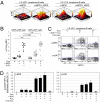B-cell signaling networks reveal a negative prognostic human lymphoma cell subset that emerges during tumor progression
- PMID: 20543139
- PMCID: PMC2919949
- DOI: 10.1073/pnas.1002057107
B-cell signaling networks reveal a negative prognostic human lymphoma cell subset that emerges during tumor progression
Abstract
Human tumors contain populations of both cancerous and host immune cells whose malignant signaling interactions may define each patient's disease trajectory. We used multiplexed phospho-flow cytometry to profile single cells within human follicular lymphoma tumors and discovered a subpopulation of lymphoma cells with impaired B cell antigen receptor (BCR) signaling. The abundance of BCR-insensitive cells in each tumor negatively correlated with overall patient survival. These lymphoma negative prognostic (LNP) cells increased as tumors relapsed following chemotherapy. Loss of antigen receptor expression did not explain the absence of BCR signaling in LNP tumor cells, and other signaling responses were intact in these cells. Furthermore, BCR signaling responses could be reactivated in LNP cells, indicating that BCR signaling is not missing but rather specifically suppressed. LNP cells were also associated with changes to signaling interactions in the tumor microenvironment. Lower IL-7 signaling in tumor infiltrating T cells was observed in tumors with high LNP cell counts. The strength of signaling through T cell mediator of B cell function CD40 also stratified patient survival, particularly for those whose tumors contained few LNP cells. Thus, analysis of cell-cell interactions in heterogeneous primary tumors using signaling network profiles can identify and mechanistically define new populations of rare and clinically significant cells. Both the existence of these LNP cells and their aberrant signaling profiles provide targets for new therapies for follicular lymphoma.
Conflict of interest statement
The authors declare no conflict of interest.
Figures






References
-
- Irish JM, et al. Single cell profiling of potentiated phospho-protein networks in cancer cells. Cell. 2004;118:217–228. - PubMed
-
- Gupta PB, Chaffer CL, Weinberg RA. Cancer stem cells: Mirage or reality? Nat Med. 2009;15:1010–1012. - PubMed
-
- Reya T, Morrison SJ, Clarke MF, Weissman IL. Stem cells, cancer, and cancer stem cells. Nature. 2001;414:105–111. - PubMed
-
- Horning SJ, Rosenberg SA. The natural history of initially untreated low-grade non-Hodgkin's lymphomas. N Engl J Med. 1984;311:1471–1475. - PubMed
Publication types
MeSH terms
Substances
Grants and funding
LinkOut - more resources
Full Text Sources
Other Literature Sources
Research Materials

